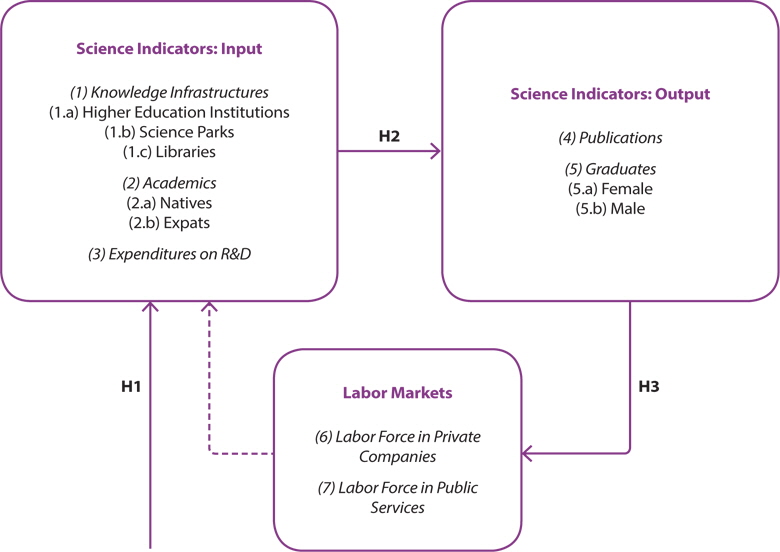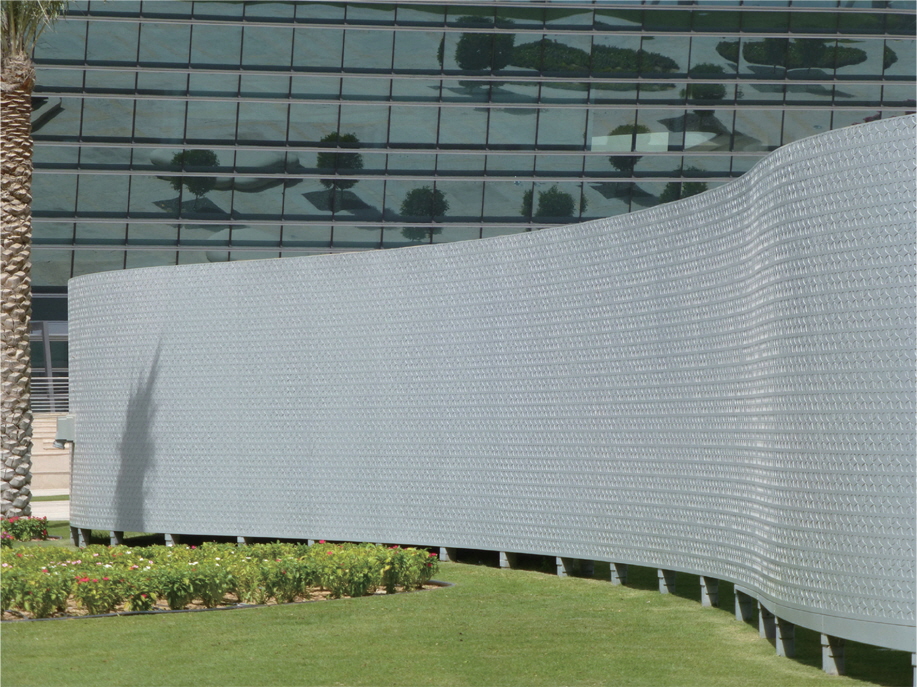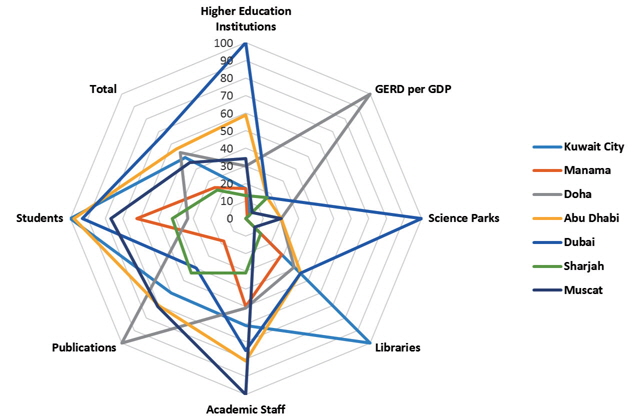



We start our journey to the Arabian Gulf with a short description of basic economic facts about the analyzed cities. Table 1 shows the GDP per capita (in Purchasing Power Parity; PPP) of 2014 at country level, as well as the number of inhabitants and the percentage of foreigners per city in the analyzed GCC countries. The GDP per capita is highest in Qatar (144,400 PPP). Ku-wait’s GDP per capita (71,000 PPP) and that of the UAE (65,000 PPP) are approximately about half as high. The other countries have a comparatively rather low GDP per capita. In comparison, the GDP per capita of the United Kingdom is 37,700 PPP and of Singapore 81,300 PPP (CIA, 2015). The number of inhabitants is highest in Kuwait City and lowest in Manama. The percentage of foreigners in Kuwait City and Muscat is around 60-65 percent. In all of the other cities the percentage is about or higher than 80 percent, and highest in Dubai (88.5 percent).
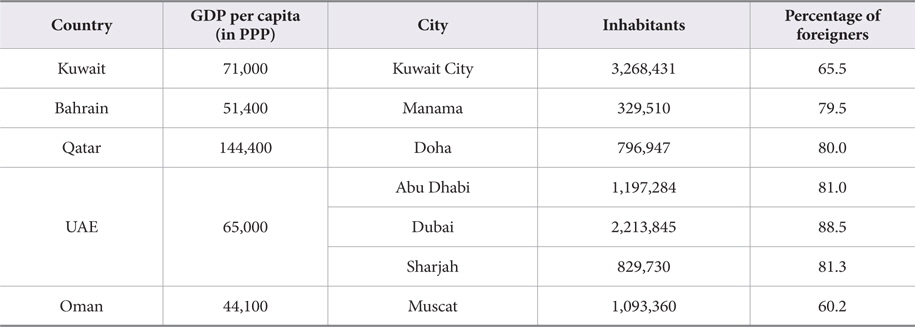
GDP Per Capita (in PPP) (2014), Number of Inhabitants and Percentage of Foreigners (2010-2013) in GCC Cities
Early on, the Kuwaiti government realized that they had to search for an oil alternative, and with it the Kuwait Vision 2035 arose: Kuwait shall be transformed into a trade and financial center, and invest in infrastructure projects such as a bridge between Shuwaikh in the north of Kuwait and the port village of Doha, a metro project and a future city (Big 5 Kuwait, 2014). This major project of Kuwait named Silk City, scheduled to be completed in 2023, is an urban area which will be divided into separate districts: business, culture, and leisure (Goldschein, 2011). There are large numbers of financial services in Kuwait.
Bahrain—one of the first states profiting from oil—has focused its after-oil strategy on tourism and finance (Hamouche, 2008). The capital Manama has become the central place of realizing projects like new holiday resorts, modern shopping malls, and tourism offers and facilities. In 2012, Manama was voted to be the Arab Capital of Culture, indicating the traditional and cultural background of the city (MOC, 2015). Due to liberal regulations on alcohol trade and consumption which are unique in the Gulf Region, Manama is well attended for parties especially by people from Saudi Arabia. The offshore banking sector located in Bahrain’s new Financial Harbor transforms Manama into one of the most important financial service centers of the Middle East. Outside of Manama you can find the University of Bahrain and a Formula One circuit.
Since the late 1990s Qatar’s capital Doha has developed rapidly into a city characterized by skyscrapers, shopping malls, museums, stadiums, and artificial islands (Adham, 2008). The Pearl, an artificial island with new apartments, houses, villas, a yacht harbor, parks, restaurants, and high-class retail strips, is already inhabited to a large part (The Pearl-Qatar, 2015). The gorgeous waterfront (corniche) and the famous Museum of Islamic Art, as well as the fact that the city will be the venue of the soccer world championship, have put Doha into the limelight. Qatar’s National Vision 2030 presents the country’s aim to be an advanced society “capable of sustaining its development and providing a high standard of living for all of its people for generations to come” (GSDP, 2008, p. 2). Qatar has invested huge amounts of capital into its education system. Remarkable institutions are Qatar Foundation’s Education City and Qatar University.
Abu Dhabi presents striking, modern skyscrapers along an almost 8 kilometer long corniche. Tourism has been identified as an economic factor: the luxury hotel Emirates Palace, the Formula One speedway Yas Marina Circuit, the amusement park Ferrari World, and Saadiyat Island as the future culture center of Abu Dhabi are only some examples of the newest investments. Abu Dhabi’s international airport carries about 16.5 million passengers annually and is the hub airport of Etihad Airways. Masdar City, an urban development project started in 2008 outside of the city will be prospectively one of the most sustainable communities for technology in the world and an emerging global hub for knowledge, research, business, and development (Masdar, 2015). In proximity to Masdar City and the airport, Zayed University is located.
In recent years Dubai has gained attention from investors and the city’s awareness increases steadily (Ali, 2010). As a consequence Dubai is developing into an important location in the range of trade, logistics, tourism, and services. Companies from all over the world settle down there (Schlüter Graf and Partner, 2010). Tourist attractions like one of the most luxurious and expensive hotels (Burj Al Arab), the tallest building in the world (Burj Al Khalifa), and the artificial island The Palm draw millions of people from all over the world. Thereby Dubai has become a constantly developing global metropolis with an international airport which carries more than 66 million passengers a year. The airport is the hub for Dubai’s international airline Emirates. There are several free trade zones, called “cities” (such as Internet City, Media City, International Academic City, etc.), hosting mostly foreign owned knowledge-rich institutions and companies.
Sharjah—the third-largest emirate of the UAE in terms of size and inhabitants (Oxford Business Group, 2008)—tries on one hand to maintain its conservative Islamic heritage, receiving the title Capital of Islamic Culture in 2014 by UNESCO, and on the other hand to adopt measures to realize the transition into a modern society. The steady development of Sharjah’s economy and infrastructure, the expansion of the economic free zones, and also the emirate’s ideal position right in the middle of the UAE, bordering all of the other six emirates, the Arabian Gulf and the Gulf of Oman, engages the interest of many investors (Scharfenort, 2007; fDi Magazine, 2013). Just outside of Sharjah, a large campus provides the infrastructure for the University of Sharjah and the American University of Sharjah.
Oman’s capital and seat of government is Muscat Capital Area—referred to as Old Muscat before 1970. Muscat has expanded its urban area in recent years and is nowadays “an urban conglomeration stretching 60 km” (Von Richthofen, 2011, p. 1). New projects are arising in terms of real estate and tourism including The Wave, a venture consisting of residential homes, hotels, retail, leisure, a marina, and a golf course (The Wave 2015), and the Oman Convention & Exhibition Centre (OCEC, 2015). Ten kilometers from Old Muscat the large campus of Sultan Qaboos University is located in a development area.
There are several articles on the transformation of higher education in the GCC countries at region-level (Davidson, 2010; 2011; Nour, 2013; Romani, 2009) and at state-level: Kuwait (Al-Atiqi & Alharbi, 2009; Wiseman & Alromi, 2003), Bahrain (Karolak, 2012), Qatar (Khodr, 2011; Powell, 2012; Powell, 2014), United Arab Emirates (Kirk & Napier, 2009; Wilkins, 2010), and Oman (Al-Lamki, 2006; Donn & Issan, 2007).
For labor markets (including the markets of knowledge workers), there are studies at the level of GCC states (Fasano & Iqbal, 2003) and for the UAE (Al-Ali, 2008), Qatar (Maplecroft, 2012), and Oman (Gonzales et al., 2008). Concerning the telecommunications infrastructure, Kaba and Said (2012) found for Arab countries a “significant progress towards developing information society” (p. 90). This progress can especially be noticed in the GCC countries. The development of an information society or a knowledge society does not only depend on a good infrastructure of information and communication technology, but also on a bundle of further aspects such as creativity, “smartness,” the labor market, etc.—and on the knowledge infrastructure as well as its outcomes, namely publications and graduates (Stock, 2011). There is no comprehensive study on the state of development of knowledge cities on the Arabian Gulf. Our study is mainly motivated by this fact.
For Carrillo, Yigitcanlar, García and Lönnqvist (2014, p. xvii), “cities are taking a leading role as both knowledge-consumption and knowledge-production hubs.” One basic aspect of knowledge cities conveys “the conglomeration of intense scientific, technological, academic, cultural and innovation activities in urban spaces operating as engines of economic productivity” (Carrillo et al., 2014, p. 3). A second basic aspect of such cities includes well-educated and creative knowledge workers (Florida, 2005) and “creative communities” (Carrillo et al., 2014, p. 4) in order to establish knowledge-based urban development. The term “knowledge cities” includes more than the pure existence of knowledge institutions and of knowledge workers in the city. All of these elements “constitute the cities’ core identity, and the way their citizens use knowledge to build their social infrastructure, their institutions and their future” (Carrillo et al., 2014, p. xvii). What does “knowledge” mean? Knowledge falls into the two aspects of skill and state: knowledge as the skill (1a) of correctly comprehending an object (“to know that”), (1b) of correctly dealing with an object (“to know how”); and knowledge as the state (2a) of a person that knows (something), (2b) that which is known itself, the content, and (2c) its linguistic expression (Stock & Stock, 2013, p. 23). In line with Stock and Stock (2013, ch. A.2) we define “knowledge” as “tacit knowledge” (bound to persons) as well as “codified knowledge” (bound to articles, books, patents, etc.). Most important for companies is tacit knowledge, i.e. the knowledge of their (knowledge) workers (Nour, 2014).
While knowledge has always contributed to economic success (Tsoukas, 2003), its importance has strikingly increased with the emergence of the information society and the knowledge society (Castells, 1989; 1996; 1997; 1998; Webster, 1995). This is shown by the percentage distribution of knowledge-based work to the GDP, which increased to more than 50 percent in numerous countries after World War II (Carrillo, 2006). The importance of knowledge and its management is, however, not only recognized by businesses but also by government, education, and healthcare (Ergazakis, Metaxiotis, & Psarras, 2004). This new awareness of knowledge in all sectors as well as the ongoing urbanization paves the way for the concept of a knowledge city (Carrillo, 2006). Ergazakis, Metaxiotis, and Psarras (2004, p. 7) define a knowledge city as follows:
A knowledge city is a city that aims at a knowledge-based development, by encouraging the continuous creation, sharing, evaluation, renewal and update of knowledge. This can be achieved through the continuous interaction between its citizens themselves and at the same time between them and other cities’ citizens. The citizens’ knowledge-sharing culture as well as the city’s appropriate design, IT networks and infrastructures support these interactions.
While cities like Barcelona, Montreal, Munich, Dublin, Delft, and Singapore have already succeeded in becoming knowledge cities (Ergazakis, Ergazakis, Metaxiotis, & Charalabidis, 2009), many other cities still strive to become one as well. Being a knowledge city implies some advantages for the city and its citizens. Among other things there exists more innovation and tolerance than in other cities, there is better education and access to information, its citizens get involved, and its economy is sustainable (Ergazakis, Metaxiotis, & Parras, 2006).
To establish a knowledge city, a city has to be focused on its design and appeal to attract knowledge workers, also called the creative class, composed of graduates and higher graduates, which is in line with Florida (2000). According to Rogerson (1999), a knowledge city’s success is sustained by knowledge workers, who have to be allured by the city itself. Only by offering a good quality of living will knowledge workers be interested in enhancing the cities’ knowledge base (Van Winden, Van den Berg, & Pol, 2007).
An important aspect of the knowledge society and also of knowledge cities is the knowledge economy. “The knowledge economy primarily involves the economic application of knowledge” (Madanipour, 2011, p. 9); it is “driven by science and technology” (p. 10) and is embedded in systems of “culture, creativity and innovation” (p. 13). Knowledge is an intangible asset, but there are tangible sites of knowledge production and knowledge consumption such as universities (Madanipour, 2011, pp. 153-160) and science and technology parks (Madanipour, 2011, pp. 160-164), as well as libraries (Mainka et al., 2013) and—combining all kinds of tangible knowledge sites—clusters of knowledge-related activities (Madanipour, 2011, p. 222), which particularly are found in knowledge cities. So the creation of higher education institutions and cooperation between universities and local companies in terms of research are important for the establishment of a knowledge city (Van Winden, 2010). According to Rosso (2007), students are a necessity for the knowledge city as well since they make up the future workforce of the city. Furthermore, the number of a city’s libraries is an important indicator “to assess the initial status of the city” (Ergazakis, Metaxiotis, & Psarras, 2006, p. 75) as a knowledge city.
Concentrating exclusively on one basic aspect of knowledge cities, namely scientific and technological knowledge, we analyze the Arabian cities regarding common methods of science indicators research. In science indicators research we find a dichotomy of two bundles of parameters: input indicators and output indicators. Godin (2007, p. 1389) puts this relationship into a very simple framework:
Input → Research activities → Output.
Godin (2007) notes, “[s]ince the early 1960s, this framework has guided analysts in organizing statistics into ‘meaningful’ categories, within the academic literature (science and technology studies) as well as official circles like OECD and its member countries” (p. 1389). Input indicators are funds, manpower (academics), and infrastructures (Stock, 1994, pp. 24-31). We will concentrate our analyses on infrastructures (task 1), academics (task 2), and expenditures on research and development (R&D) (task 3). For task 1, we differentiate between (public, national, private, and branch campus) higher education institutions (task 1a), science parks (task 1b), and libraries (task 1c). With a focus on public and national libraries we are leaving the academic sector and study information dissemination for all citizens. As we were not able to identify figures on funds (task 3) at city-level, we present data for countries. Output indicators are either performance or impact indicators of academic research results and the results of academic teaching. Research performance indicators are publication counts (Stock, 1994, pp. 51-61), where impact indicators are citation rates; teaching performance indicators are numbers of graduates and their impact indicators the successful transformation of graduates into the labor markets (Stock, 1994, pp. 38-45). We are going to study publication output (task 4) and the number of graduates (task 5), while we differentiate between female (task 5a) and male graduates (task 5b). Arab countries were and are male-dominated societies, so it seems to be important to include the gender aspect into our studies.
Scientific, technological, and medical (STM) outputs are no ends in themselves; they are rather “throughput.” The decisive moment is the transformation of STM output into economic and societal practice (Stock, 1994, p. 12), be it by application of the results of publications, or be it through employment of well-educated graduates. In order to analyze such transformations into practice, we have to study the labor markets of graduates in both private companies (task 6) as well as public services (task 7). To complete the whole picture, there are links between public services as well as private companies and input indicators, insofar as they fund knowledge infrastructures and academics or cooperate with academics. Fig. 2 presents our research model, which is based upon knowledge city research and science indicators. Seen from a comprehensive approach of knowledge city research (as, e.g., Carrillo et al., 2014), we only study tiny parts of knowledge cities, for example missing aspects of knowledge management at city-level (Stock, 2011) or knowledge-based environmental neighborhood projects. At any rate, our indicators are essential for every city dealing with the knowledge society.
Derived from our research model, we formulate three hypotheses:
H1. The Gulf cities have created knowledge infrastructures and allocated manpower (in terms of higher education institutions, science parks, libraries, academics, and expenditures on research and development) to guarantee adequate input for knowledge cities.
H2. Based upon the knowledge infrastructures, in regard to academic staff and expenditures on R&D, in the Gulf cities there is an output (in terms of publications and graduates) to guarantee the local knowledge base.
H3. Based upon academic output (in particular from graduates), local private companies and local public services (especially higher education institutions) in the Gulf cities profit by the well-educated and motivated work force.
In order to confirm or disprove the hypotheses, we employ a set of methods leading us to empirical data and to arguments for or against the hypotheses.
This article is part of a larger research project on informational cities (Stock, 2011; Mainka et al., 2013). Besides the knowledge city, our research considers the creative city, the smart city, the digital city, the city’s company structure and the labor markets, the political willingness to construct or rebuild the city into an informational city, soft location factors, and the information behavior of the citizens. In this article, we focus on the important aspect of knowledge cities. To obtain and analyze the relevant data for our study we applied different methodological approaches to Kuwait, Manama, Doha, Abu Dhabi, Dubai, Sharjah, and Muscat. The chosen methods have already been applied to several other studies. Fietkiewicz, Pyka and Stock used these approaches to examine Japanese communities in terms of informational cities (Fietkiewicz & Pyka, 2015; Fietkiewicz & Stock, 2014, 2015; Fietkiewicz, Pyka, & Stock, 2015). Khveshchanka, Mainka and Peters (2011) analyzed Singapore, and Murugadas, Vieten, Nikolic and Mainka (2015) London as informational cities.
The investigation of knowledge cities is based on the Grounded Theory Method (GTM) by Glaser and Strauss (2009 [1967]). It describes a collection of methods that contribute to the construction of a theory based on data. In social research that data is systematically gathered with the help of sources like literature, statistics, or interviews. GTM can be utilized for new developing phenomena and does not exclude any disciplines (Glaser, 1992). This major flexibility of the GTM was crucial to our decision to use it for our research.
The main part of our research was the conducting of interviews in the Gulf cities as well as the field research during which we could gather individual impressions. We started off with literature research to determine the state of the art of research. In the next step we chose our interviewees carefully, looking for people who are experts in different urban knowledge related fields and familiar with the development in their city. During the actual interview we wrote memos and organized and analyzed the received information after each interview.
As a method of data collection we carried out a kind of ethnographic field study which deals with the understanding and characterization of a nation, a culture, or a city. A field study describes the active approaching of the world and its people in order to understand nations and cultures. It is important to observe the research interest for a certain period of time (Brewer, 2000). Ethnographic field study proposes aspects including the collection of quantitative data, participant observation, photo and video documentation, and the conducting of interviews. These methods seemed especially suitable in terms of our study. While studying the cities, we took an immense amount of pictures which we arranged by matching them apposite to the investigated indicators. Due to the fact that we visited the cities only for a few days each, our on-site research is a kind of “rapid ethnography” (Millen, 2000).
The interviews that we conducted between the 18th of February and the 6th of March, 2013 in Abu Dhabi, Doha, Dubai, and Manama (team 1: Adriana Kosior, Agnes Mainka, Wolfgang G. Stock) and between the 28th of March and the 9th of April, 2014 in Kuwait, Muscat, and Sharjah (team 2: Julia Barth, Julia Gremm, Fee Hilbert, Wolfgang G. Stock) were an important part of the field study. We decided to combine qualitative and quantitative methods and chose a questionnaire which consisted of closed questions for the quantitative results. In the course of the interviews we elaborated on the discussed topics by posing further questions. This can be seen as a semi-standardized technique since the questionnaire only helps as a guide during the interview.
With the help of statistics, statements about the investigated indicators can be made. Official statistics that come from ministries are normally preferably used. Numeric values, if ascertained by unified methods, also contribute to a facilitated comparison of different cities. However, there is no such system in the Gulf Region that uses standardized methods to gather and review their statistical data. As a result, we had to resort to numerous sources of statistics that provided information about the knowledge city and compared them as possible. In some cases only data for state level were used. This will help us to draw inferences about the city because the states in the Gulf Region are known for their vibrant city regions where most of the population lives (El-Haddad, 2003). Working with data at state level is problematic for the UAE though. This is because a distinction between Abu Dhabi, Dubai, and Sharjah cannot be made.
The number of scientific publications in each city as part of its scientific output can be ascertained with the help of the interdisciplinary database
After collecting and evaluating the available numerical data for each city, we compared the seven cities with one another. The aim is to get a ranking of the cities for our knowledge city index. To achieve the ranking, the collected data have to be standardized. We compared the collected numeric data of each indicator for Abu Dhabi, Doha, Dubai, Kuwait, Manama, Muscat, and Sharjah. For each chosen indicator, we assigned the normalized value of 100 to the city with the best result. Since some of the indicators were unsuitable due to reasons like missing or incomplete information, we did not use all of them for the normalization. The normalized values of the other cities were received by dividing the numeric value of each of those cities by the non-normalized value of the city with the best result. As an example: If Dubai has the highest number of universities (namely 53) the normalization value is set to 100. Cities with lower numbers, like Abu Dhabi with 31 universities, are set in ratio to the city with the best result (here: Dubai). Their normalization value is calculated by the formula:
normalization value * actually analyzed value / value set to normalization of 100,
which corresponds to 100 * 31 / 53 = 59 in the example. For each indicator there are seven standardized values, one for each city. Concluding an average result for each city as a knowledge city can be calculated on average. To receive the average values that are used for the ranking, we added up the normalized values per city and divided the interim result by the quantity of the used values. The city with the highest average value does best with regard to the index.
4. KNOWLEDGE INFRASTRUCTURES, ACADEMICS, AND EXPENDITURES ON R&D
How do Kuwait, Manama, Doha, Abu Dhabi, Dubai, Sharjah, and Muscat fit into the concept of a knowledge city? To answer this, we analyzed all input indicators which are known in science indicator and knowledge city research: the knowledge infrastructures (task 1), i.e. the number of higher education institutions (task 1a), the number of science parks (task 1b), and the number of libraries (task 1c); the number of academics (task 2) and their origin (natives: task 2a; as well as expats: task 2b), and expenditures on research and development (R&D) (task 3).
4.1. Higher Education Institutions
“For centuries the most common form of education in the six Gulf monarchies was the kuttab, where a group of boys or girls were taught to recite the Qur’an and sometimes learned some basic writing and arithmetical skills” (Bahgat, 1999, p. 129); in the 1950s in most of the Gulf States the foundations of a modern school system were laid. The first universities came decades later. Kuwait University was founded in 1962; the Gulf Technical College in Bahrain followed in 1968. In the Emirates, the UAE University in Al Ain was founded in 1976, and Zayed University, based in Abu Dhabi as well as in Dubai, began in 1998. The University of Qatar in Doha was established in 1973, and Muscat’s Sultan Qaboos University opened in 1986.
In the GCC countries, we find three kinds of higher education institutions: (1) public institutions (as, in the UAE, the UAE University, the Higher College of Technology, and the Zayed University); (2) local private institutions (as, e.g., the American University in Sharjah, the University of Dubai, and the Paris-Sorbonne University Abu Dhabi); and (3) international branch campuses (as, e.g. the campus of the University of Woolongong, Australia, which was the first international university, established in 1993) (Wilkins, 2010).
A branch campus is “an offshore entity of a higher education institution operated by the institution or through a joint venture in which the institution is partner” (Becker, 2010, p. 3). In 2010, Becker reported on 162 branch campuses all over the world, which are dominated by institutions from the United States. Among the host countries, the UAE take the leading position. In the UAE, there are 40 international branch campuses; about two-thirds of these are located in Dubai Academic City (Becker, 2010, p. 4), the others in Abu Dhabi and in Sharjah. In Doha, we find 9 branch campuses, all of them located in the city district “Education City.” Similar to other “cities” in the Gulf cities, in “Academic Cities,” “Education Cities,” “Knowledge Cities,” etc. the branch campuses are 100% foreign ownerships; there is a 100% repatriation of profits and no tax (Becker, 2010, p. 4). In Doha’s Education City, the Qatar Foundation bears all the costs of the infrastructures and of administrative assistance to the international universities.
The density of offshore campuses in the Gulf Region seems to be a regional phenomenon (Miller-Idriss & Hanauer, 2011), induced by the speed of transformation of the higher education systems in this region. The branch campuses lead towards “the Westernization— indeed the Americanization” of the Gulf cities’ tertiary systems (Witte, 2010). On the other hand, we can identify some benefits of branch campuses. Since there are many international higher education institutions in the Gulf cities, more nationals may decide to study at home instead of abroad. It is possible to study, for example, at New York University Abu Dhabi and to get a diploma from NYU. Because the students do not leave their country, the brain drain of Gulf nationals is reduced (Wilkins, 2011, p. 77). Although it would be possible for expatriates to attend a public university (with its specific rules, e.g. gender separation), most of the children of foreign families tend to study at international branch campuses (Wilkins, 2011, p. 78). In international universities, the instructional language is English; in public universities, the language depends on the subject taught. Courses in business administration, medicine, or engineering are mainly taught in English, while education,
University infrastructure at the Gulf has grown impressively during the last two decades (Mukerji & Jammel, 2008): “Throughout the 1990s, in the Arab world, 10 new universities were established annually” (Donn & Al Manthri, 2010, p. 97). Thenceforth universities have to fulfill several roles: “ending illiteracy, diversification of hydrocarbon-based economies and preservation of cultural integrity” (Weber, 2011, p. 1). For instance, in Doha most of the universities grew up when Qatar Foundation’s Education City was founded. This is an international campus, with about 1,000 hectare located near the city, that draws students from all over the world (Frank, 2006; Powell, 2014, Weber, 2014): “Amongst QF (Qatar Foundation; A/N) initiatives in the field of higher education, Education City is the one having the most visible urban outcomes in Doha” (Rizzo, 2013, p. 541). There on the outskirts mostly international worldclass universities are clustered on a large campus (Davis, 2010). Major American and European university branch campuses are partnered and established in this area (Gyeszly, 2010), whereby graduates’ qualifications are not equivalent to their respective American and European institutions (Interview partner DO1).
Also in Sharjah, most of the universities and higher education institutions are positioned next to each other in an area called University City, which is a cluster for knowledge institutions (Interviewee MU3). Dubai builds up such areas likewise, including Dubai International Academic City and Dubai Knowledge Village. In total about 60 percent of Dubai’s institutions are located inside one of those free trade zones (KHDA, 2013).
As it turned out during the field research, in contrast to private universities (Godwin, 2006) some public universities in the Gulf Region even today teach gender-segregated, including Qatar University. Female and male bachelor students study separately and even have their own libraries. Collections are doubly present, but are mostly called up digitally (Interview partner DO1 and DO2). Indeed, nowhere else in the Gulf it is as strict as in Zayed University, one of the federal universities in Abu Dhabi: Female and male bachelor students were separated by a wall in the middle of the campus (Figure 3). This is due to local social conventions. Thus female students are not allowed to leave the campus without the approval of their parents, or if they are married, of their husband (Bristol-Rhys, 2008).
Today, Dubai has by far collectively the highest number of (however, small) universities and other higher education institutions (Table 2). Also Abu Dhabi (31; normalized value: 59), Muscat (18, normalized value: 34), and Doha (16, normalized value: 30) have high numbers of institutions of higher education. But the quality of most of the institutions, in Dubai or the rest of the Gulf Region, can match up to American and European standards only in rare cases (Schröder, Kuta & Haidar, 2010).
[Table 2.] Institutions of Higher Education in the Gulf Cities
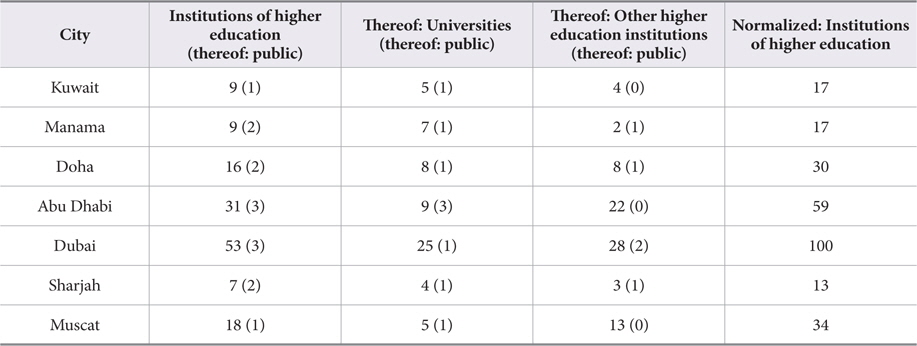
Institutions of Higher Education in the Gulf Cities
A huge problem of building up these knowledge areas is the great distance to the Gulf cities’ centers, up to 30 kilometers. This and missing metro systems demands flexible mobility by the students and staff. The increasing number of students and the fact that the only way to arrive is by car causes traffic jams at Arab universities like Sultan Qaboos University (SQU) in Muscat (Abdul-Wahab & Fadlallah, 2014). Also near German University of Technology in Oman (GUtech) we found only desert kilometers around. Qatar’s Rail Development Program still includes a plan of four lines—in Central Doha underground and on the outskirts mainly grounded or elevated—with stations at Education City and Qatar University (Qatar Rail, 2015). Other plans are not known.
To get an idea about expenditures for studying at an Arabian university we exemplarily adduce Qatar University in Doha and Sultan Qaboos University in Muscat—both public. At Qatar University a bachelors program costs between 109 and 164 USD per credit hour (QU, 2015). Prices for masters programs in Muscat vary between 195 and 325 USD and are therefore only some dollars cheaper than masters costs in Qatar (SQU, 2015). In total, prices at public universities are approximately equal. But one exception attracts attention: Abu Dhabi and Dubai bachelor studies at public universities are free (Interview partner AD2). It is needless to say that private institutions charge advanced prices, which is no entry barrier for Kuwaiti, Bahraini, Qatari, Emirati, and Omani students, often coming from affluent homes.
By funding of the Qatar Foundation the Qatar Science and Technology Park (QSTP) opened in 2009 inside the area of Education City. The research has a focus on energy, environment, health, and ICT and should support Qatar’s post-oil and gas economy. QSTP is the only science park in the Middle East that is cooperatively located in a collective area with internationally prestigious universities. In 2012, about 50 companies (for example GE, Microsoft, and ExxonMobil) were based on these grounds (Frank, 2006; QSTP, 2015; Weber, 2014). The out-of-town arcology project Masdar City, located next to Abu Dhabi, will prospectively include a Science and Technology Park (Masdar, 2015). In addition, a technology park named CERT Technology Park that was founded by the Higher College of Technology, which is one of the public universities in Abu Dhabi, is located in the city. The exchange of technical knowledge and expertise should be promoted by this institution (CERT, 2015). Dubai houses the most range of science parks (Table 3). The bioscience cluster Dubai Biotechnology & Research Park, the technology-oriented Techno Park, and the energy and environment park Enpark are indicators of an active development of science parks in Dubai (DuBiotech, 2015; TechnoPark, 2015; Enpark, 2015). Additionally the technology park Internet City, harboring firms like Microsoft and IBM, and the business community Media City are located in Dubai’s free trade zone next to Dubai Knowledge Village. Together they build up the first knowledge cluster in the region (Dubai Internet City, 2015; Dubai Media City, 2015).
[Table 3.] Science Parks in Arab Cities
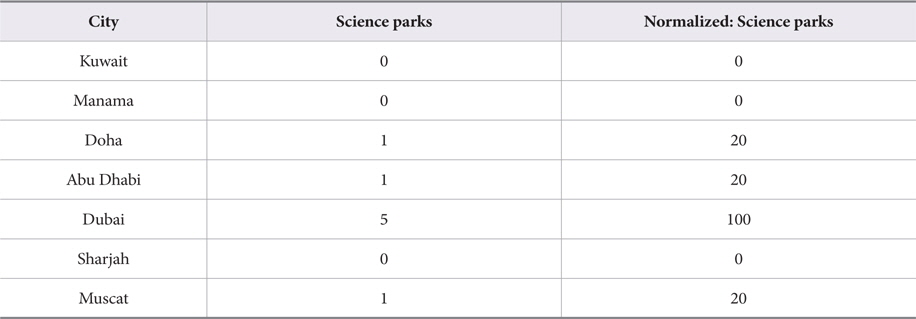
Science Parks in Arab Cities
Also in Muscat one science park is located: Knowledge Oasis Muscat (KOM). The park was established in 2005 and built to encourage technology-oriented and thus knowledge-intensive businesses due to their increasing importance. The science park consists of over sixty companies, and even two IT-Colleges are located in the KOM (Al Shmeli, 2009).
Kuwait houses 41 academic and special as well as public and national libraries (Table 4), which is clearly the highest amount compared to the numbers of the other Gulf cities. However, interview partner KU4 remarks that public libraries in Kuwait are hardly visited since the citizens are not interested in reading. However, the field research revealed that impressive libraries like the
[Table 4.] Libraries in Arab Cities
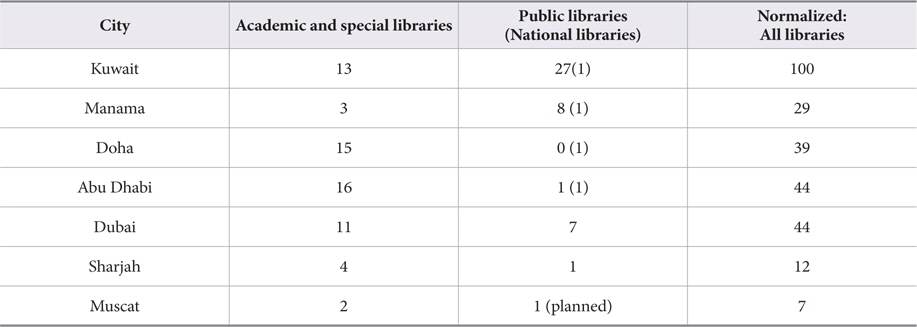
Libraries in Arab Cities
One can find national libraries in all states except Oman, where such a library is planned. In Bahrain, the national library is part of the Isa cultural center. The university libraries meet the same standards as Western academic libraries. They not only present books on shelves, but ebooks and further digital media as well. We found impressive academic libraries, e.g. in Qatar University or in Zayed University Abu Dhabi.
Most of the other Gulf cities rather seem to disregard the library system (Interview partner MA3, DU2), whereby the Qatar Foundation plans a future location of the new
In addition, librarians at the Gulf attach great importance to incorporating information literacy courses into their libraries. As an example, the American University of Sharjah Library “paid special attention to the design and placement of classroom facilities to ensure that the library’s information literacy and instruction program, a critical component of the library’s mission, could be delivered more effectively” (Ritchie & Ray, 2008, p. 167). The result: Group study rooms, presentation rooms, and bookable seminar rooms were equipped by the person in charge. Moreover, all librarians are trained in information literacy skills. They are able to assist library users hereafter and to teach them MS Office Tools, library and IT basics like student folders, and library resources (Ritchie & Ray, 2008). Within the scope of e-resources, Education City’s university libraries play a significant role: The number of accessible e-books, e-journals, and online databases is extremely high and the computer literacy, based on the students’ specialized scientific education, allows the students to use the resources 24/7 (Gyeszly, 2010).
4.4. Native and Foreign Academics
Our task 2 asks for the number and the nationality (tasks 2a and 2b) of academics. Oman has the highest number of academics, namely 3,092. Abu Dhabi follows with 2,499 academics. The academic staff of Sharjah has with 968 the fewest members.
The most striking feature concerning the academic staff is that there are mostly more non-citizens than citizens employed at higher education institutions in the Gulf Region (Table 5). The only known exception is Kuwait City, where the number of citizens exceeds the number of non-citizens. Following KU4, the majority of the academic staff at private institutions in Kuwait City are foreigners and citizens would rather work at public universities. Natives do not work at private universities and especially not at the branch universities located in the Gulf Region. For many years in a row now, nearly all of the academics in private or branch universities of the cities in the Gulf Region have been foreigners. Most of the academics are expat Arabs who have a Ph.D from the United States or Britain. In the eyes of Gulf nationals, education is not an attractive profession (Gill, 2008).
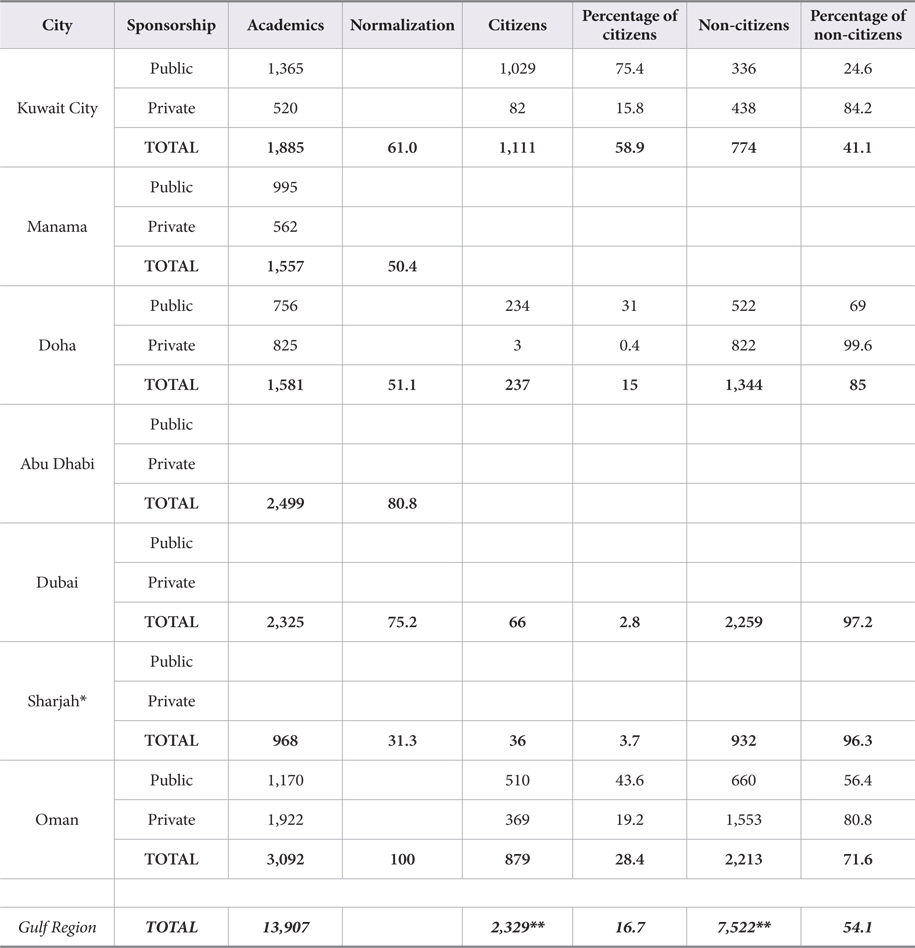
Number of (National and Foreign) Academics in Higher Education Institutions in the Gulf Cities by Origin and by Sponsorship of the Institution (2011/2012)
Oman, with the highest number of academics, receives the highest normalized value possible. It has to be kept in mind that in Oman there are some higher education institutions outside of Muscat which are also included in the numbers for this indicator, since the statistics do not give more precise data.
4.5. Expenditure on Research and Development
The typical indicator for expenditures of R&D at country-level is GERD per GDP (task 3). GERD is the Gross Domestic Expenditure on R&D, and GDP means the Gross Domestic Product. A “good” value of GERD per GDP is about 3%. Top-scoring countries in the world are Israel (4.2%), South Korea (3.6%), and Japan (3.4%) (all figures from 2013; Battelle, 2013, p. 7). Qatar’s value of 2.8% is relatively high, comparable with the United States (2.8% as well), Germany (2.87%), and Singapore (2.65%). All other values on R&D expenditures of the GCC countries are low (UAE with 0.47%) or very low (Oman: 0.13%, Kuwait: 0.09 %, and Bahrain: 0.04%) (Table 6).
[Table 6] Expenditures on Research and Development in GCC Countries (2013)

Expenditures on Research and Development in GCC Countries (2013)
5. ACADEMIC OUTPUT: PUBLICATIONS AND GRADUATES
Indicators of academic output are publications by academic staff (task 4) and the number of students as well as the number of graduates (task 5).
In the years from 2000 to 2014 the number of scientific publications of the Gulf cities (task 4) in
[Table 7.] Number of Publications in the Gulf Cities (2000-2014)
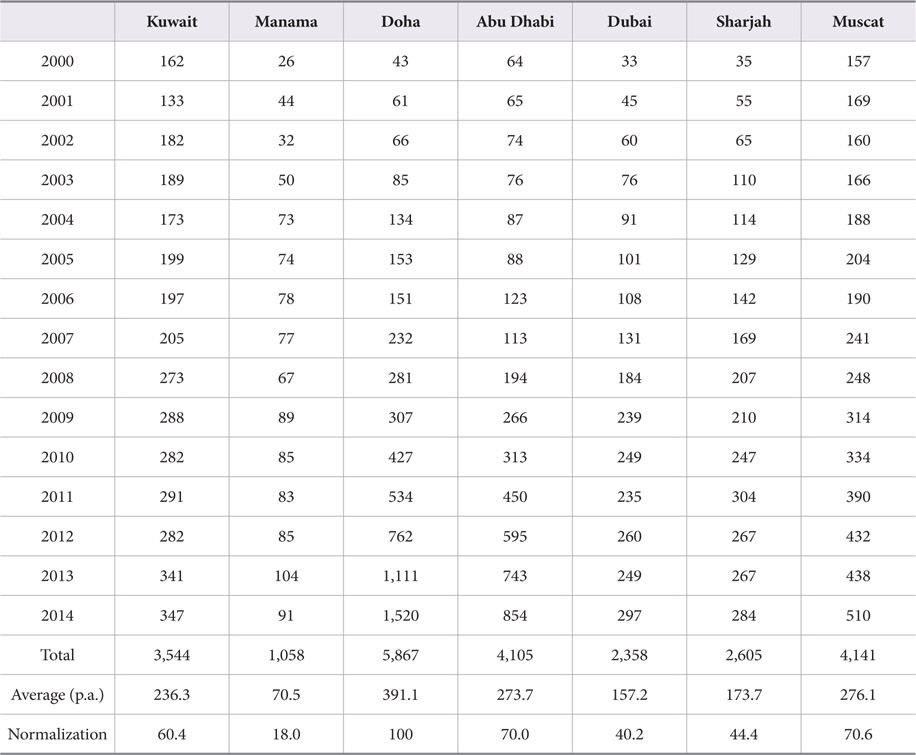
Number of Publications in the Gulf Cities (2000-2014)
The sharp increase in publication numbers is visible in all cities in the Gulf Region. However, when comparing these numbers to London as an example of an advanced informational city (Murugadas, Vieten, Nikolic, & Mainka, 2015) there is still a very clear difference. While cities in the Gulf bring out between a minimum average of 71 (Manama) and a maximum average of 391 (Doha) publications per year, the average number of publications per year of London amounts to 31,216. The emerging Informational City Singapore published already in 2009 more papers than all of the Gulf Cities in 2014 (Khveshchanka, Mainka, & Peters, 2011). In the Gulf region, the expectation to do research exists, but the striving after research output is not very high (Gill, 2008).
In most of the cities, the majority of publications come from one single institution. In Kuwait, Manama, Sharjah, and Muscat more than 50 percent of all published papers were written by authors from only one university in the city. In Kuwait 65.2 percent of all publications were written by employees at Kuwait University. 54.3 percent of the papers written in Manama were published by the Arabian Gulf University, and 74.2 percent of all papers from Muscat were written by authors of Sultan Qaboos University. In Sharjah 81.8 percent of all papers were written by employees at the American University of Sharjah. By implication this means that all other universities in the cities are mostly engaged in teaching and neglect their research output.
In the last few years, the number of students in higher education institutions in the Gulf Region is rising. This increase is most distinct in Kuwait City where the number developed from 42,084 students in the academic year 2010/2011 to 51,851 students in 2012/2013. Alpen Capital (2015) has published numbers from 2013. According to these figures, 97,627 students were enrolled in the universities and colleges of Kuwait City in that year. That number neither gives any hints about the distribution of females and males nor distinguishes between private and public institutions. Because of this it is not sufficient for the present study. Table 8 shows that Kuwait has, compared to the other researched cities, the highest number of students and Doha the lowest. However, when comparing each city by the number of students relative to the population, Manama (as a small city) does best with 9.8 percent and Kuwait (as a very large city) has the lowest percentage. In nearly all the examined Gulf Cities, there are more female students than male students. The only exception is Dubai where there are 12.2 percent more male students than female students in the academic year 2012/2013: “This imbalance is often attributed to men travelling overseas to study, while families in this conservative region will often not allow their daughters to follow suit” (Gill, 2008, p. 2). Others are of the opinion that the reason for this characteristic is that females have more time to study and are also more interested in studying since they have to stay home otherwise. Studying gives them the opportunity to get in contact with other people (Interviewee MU3). Interviewee DO2 states that males have far more career opportunities than females. They can go to the army or enter into civil services while females have no other chance except to study. When we visited Zayed University in Abu Dhabi about noon, the girls’ campus was very busy; there were many female students and dozens of boards with political information or with foodstuffs. As we changed to the boys’ sector, we found rest—and apathy. There were only a few male students and no information desks at all.
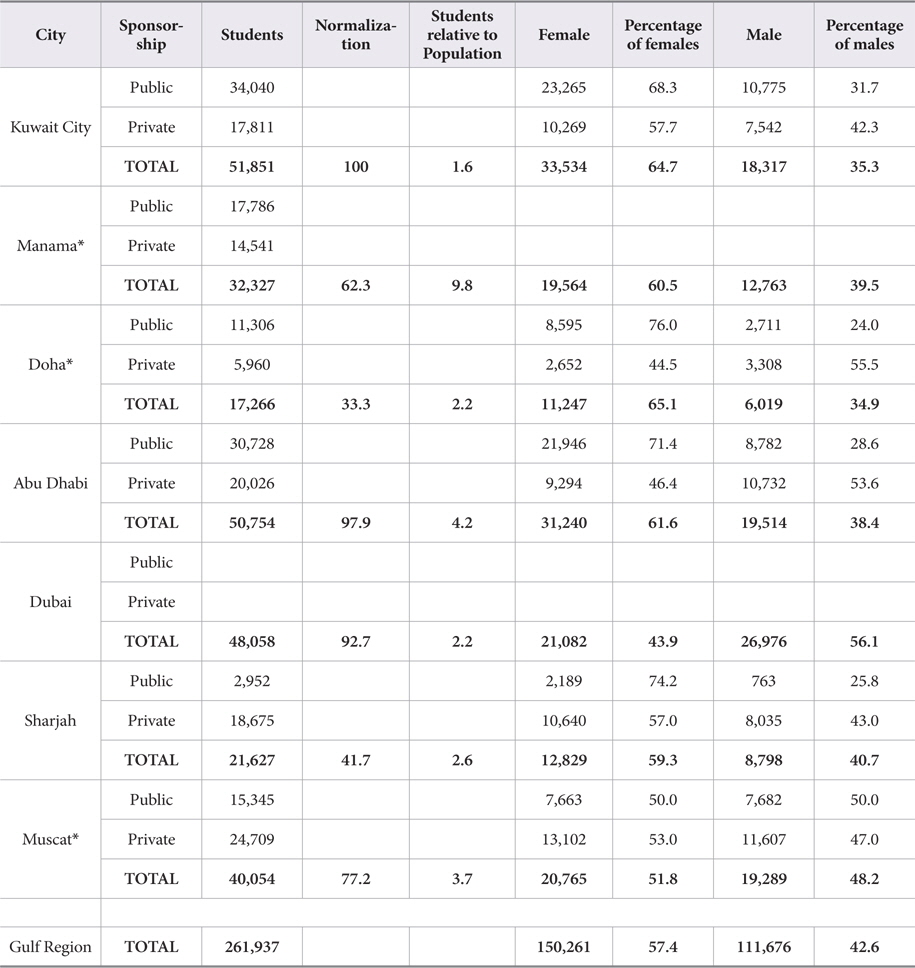
Number of Enrolled Students in the Higher Education Institutions in the Gulf Cities by Gender and by Sponsorship of the Institution (2012/2013)
In general, data concerning the number of graduates in a city seems more relevant to us than the number of students, since graduates are the ones that are qualified to transfer into the labor market. However, we additionally examine the number of students and use the statistics for our normalization because the statistics about graduates are not sufficient.
The number of graduates in the Gulf Region is considerably low but it has slightly increased within the last few years. Compared to the other cities in the Gulf Region, Dubai has the highest number of graduates. There are 9,139 graduates in total in the academic year 2011/2012 (Table 9). Generally more female students have graduated in the last few years in the examined cities, which is not striking since the number of female students is mostly higher than the number of male students. Again, the only city where the distribution is different is Dubai, where the majority of graduates in the academic year 2011/2012 are males. According to Thomas, Raynor and Al-Marzooqi (2012) females not only graduate but at the undergraduate level they also outperform males in nearly every discipline.
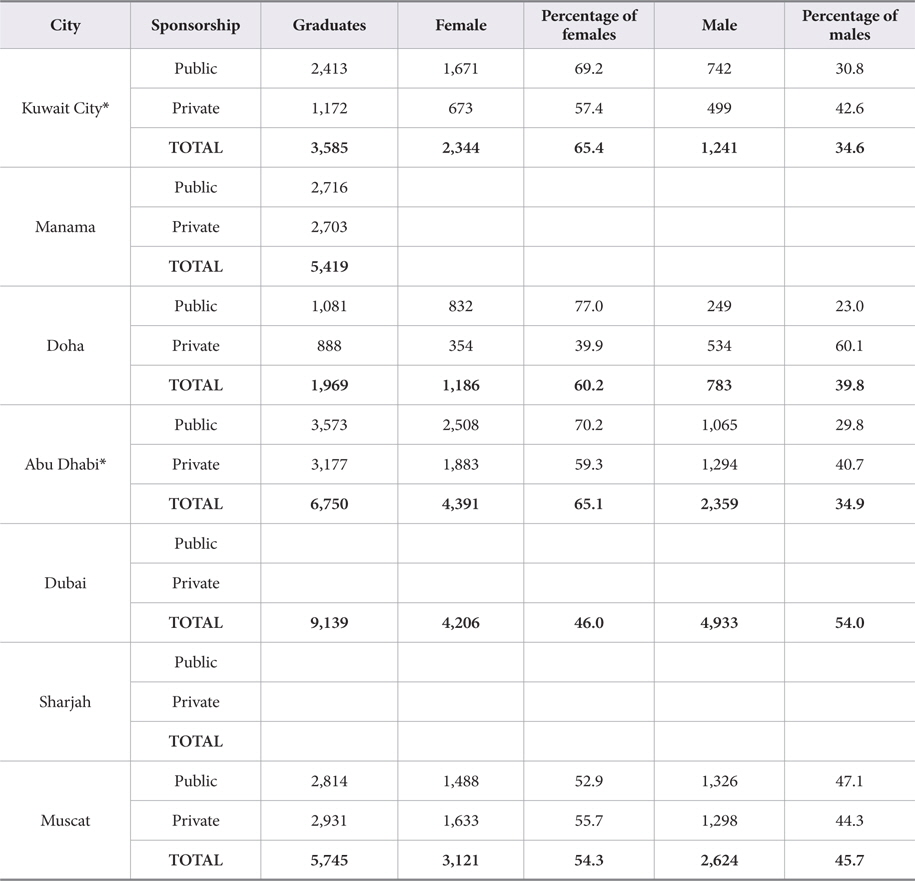
Number of Graduates in the Higher Education Institutions in the Gulf Cities by Gender and by Sponsorship of the Institution (2011/2012)
In the case of the analyzed cities there is always one university per city where the majority of graduates have studied. In the academic year 2011/2012 Doha had 1,969 graduates, and of these 1,081 graduated at the Qatar University. The number of post-graduates is in all the cities much lower than that of graduates.
When comparing the number of graduates of the cities in the Gulf Region to that of London and Singapore, it becomes obvious that even though the Gulf Region is making progress, it has not yet reached the level of the pioneer cities. None of the cities in the Gulf Region have had 10,000 graduates or more yet, while the number of graduates in Singapore was already higher than 40,000 in 2009 (Khveshchanka, Mainka, & Peters, 2011). In London there were 143,791 graduates in the academic year 2011/2012 (Murugadas, 2013). Dubai, the city with the highest number of graduates, does not even reach 10 percent of the graduates in London.
6. TRANSITION INTO THE LABOR MARKETS
The transition of graduates into the cities’ labor markets and their success in companies or administrations (task 6 and 7) depends on two important aspects: on the one hand the quality of the graduates’ education and on the other hand the motivations of the graduates to work—especially in knowledge-intensive positions in public institutions (e.g., universities) and in private companies. For the UAE (and for other Gulf states as well), it is accepted as true “that education needs to transform itself in line with the demands of the workplace and the knowledge economy” (Nicks-McCaleb, 2005, p. 332).
Looking at the labor market situation of the last decades in the Gulf Region, it is remarkable that the expatriate workforce increased continuously. Due to the discovery of oil in this region, more and more expats arrived, stayed almost permanently and today work primarily in the private sector (Kapiszewski, 2006). Actually, the natives—working primarily in the public sector—live in a convenient situation with attractive salaries and less particularly demanding work (Naithani & Jha, 2010). For some time, this circumstance started to change. Due to the fact that the public labor market is saturated and the environment in the private market is too competitive for the majority of them, inter alia Kuwaitis, Omanis, and Emiratis have difficulties in finding a job (Kapiszewski, 2006; Moideenkutty, Al-Lamki, & Rama Murthy, 2010). As a result, “the last two decades have been characterized by a substantial increase in average unemployment rate in the countries” (Al-Qudsi, 2005, p. 1) at the Gulf. As stated above, the native employees depend mostly on employment opportunities in the public sector, “even though it is monotonous work routine and offers very less scope for professional development” (Vinod et al., 2014, p. 747).
The governments have already noticed the unusual distribution in the labor market. Therefore, they try to create adequate job opportunities for natives to limit dependence on foreign workers (Kapiszewski, 2006) and to localize the labor market while expatriates are to be replaced by natives (Godwin, 2006). These nationalization programs are called Emiratization, Omanization, or Kuwaitization, for example. The nationalization programs are successful concerning government agencies (Godwin, 2006), but fail in many cities concerning private companies: “UAE nationals prefer to work in the government sector due to higher salaries and better employment conditions, which has resulted in a very small percentage accepting employment in the private sector” (Godwin, 2006, p. 9). Until now, nationalization programs have shown only minor results in UAE and Qatar (Naithani and Jha, 2010), but in comparison to these Gulf States Bahrain, Kuwait, and Oman have an increasing number of native employees in the private sector. Despite all, employment in the private sector is still particularly unattractive for natives. The regular working hours are long, the environment hard to accept, and the payment is usually quite low; “The UAE nationals are a rare, protected minority group in the private sector, in spite of the government’s effort to nationalize the workforce” (Tong & Al Awad, 2014, p. 70).
Perhaps there is a lack of motivation of especially male graduates to work in knowledge-intensive and innovative jobs. In all Gulf cities, the Muslim religion is a crucial part of citizens’ lives. For the Qur’an, knowledge is with God; and it is no indicator of high cultural status to be well-educated: “Unlike in western societies, Gulf State citizens generally do not perceive their schools to be means for reproducing cultural status” (Wiseman & Alromi, 2003, p. 209). Of course, there are changes in the educational system of the GCC states, but these cultural and religious values and ideas are still present in the background. If a national does not or will not work, he or she will not live in poverty in many of the analyzed cities: “For Emiratis who don’t work, the welfare safety net is lavish. The average man collecting welfare benefits receives $55,000 a year. … To be an Emirati is to be high born; even Dubai’s public housing flats include a servant’s room” (Brook, 2013, p. 371).
Women prefer to work—just like men—mainly in public services. By 2009, in the UAE “Emirate women comprised 66 percent of the workforce in the government sector, of which nearly one-third were in middle and senior management positions” (Forster, Al Ali Ebrahim, & Ibrahim, 2013/14, p. 34). Women enjoy equality of opportunity in the workplace, including pay equity with men. Forster, Al Ali Ebrahim and Ibrahim (2013/14, p. 39) report on “best public-sector payrates and benefits in the world,” short working hours, and generous holiday entitlements. About two thirds of the women in the public sector work on average 7 to 8 hours a day, including time spent on work-related duties at home and commuting hours (Forster, Al Ali Ebrahim, & Ibrahim, 2013/14) leading to a perfect work-life balance for Emirati women. So for women there is no single motivation to work in the private sector (which involves many more working hours and less income).
The transition of graduates into knowledge-intensive labor markets is problematic. National male as well as female graduates prefer jobs in public services. They tend to disregard jobs in private higher education institutions, in companies of the knowledge parks, in libraries, and in other knowledge-intensive private companies. Nearly all positions in private companies and also huge amounts of jobs in public higher education institutions are filled with expats. Programs of nationalization of the private sector show either no results (in Doha, Abu Dhabi, Dubai, and Sharjah) or only minor success (in Kuwait, Manama, and Muscat). National women are more motivated to study than males. The female graduates constitute—even in higher management positions—the majority in public services. It is an open question for us how—in a traditional male-dominated society—men will react when they find out that the city’s management elite is female. Do native males continue to prefer their passive status in a rentier state (Beblawi, 1987)? Or will they change their behavior?
To sum up our quantitative findings we aggregated all indicator values into one table (Table 10). So we are able to compare the cities among each other (Fig. 4). Dubai is equipped with the most higher education institutions; Doha invests by far the highest amount of money into its R&D system; in Dubai we find the most science parks, while there are the most libraries in Kuwait; in Oman there is the largest academic workforce (if we neglect this country-level value, Abu Dhabi is top concerning academic staff); Doha produces the most Web of Science-covered scientific articles and, finally, Kuwait has the maximum number of students. For every city we calculated the mean of the normalized values and created a ranking. In the internal comparison of the seven Gulf cities, Dubai, UAE is top concerning its status as a knowledge city, followed by Abu Dhabi, UAE, and Doha, Qatar. We find Kuwait City, Kuwait, and Muscat, Oman in the middle field, while the smaller cities Manama, Bahrain, and Sharjah, UAE are in the lower ranks. Compared with highly developed informational cities as London or Singapore, the absolute values of the Gulf cities are rather low.
[Table 10.] Normalized Knowledge City Indicators for the Arab Gulf Cities
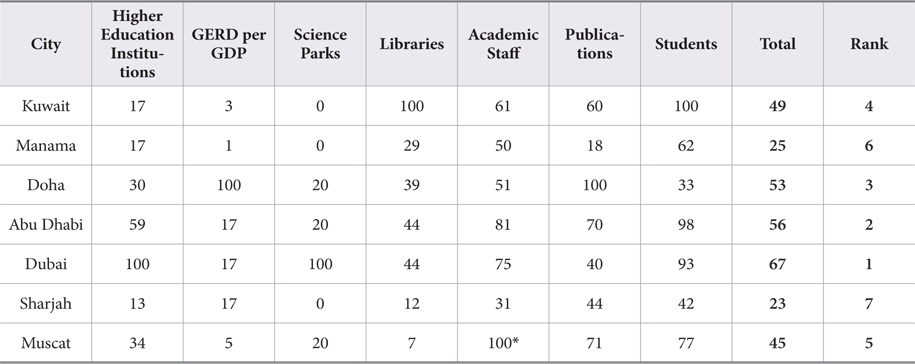
Normalized Knowledge City Indicators for the Arab Gulf Cities
How can we interpret these empirical findings? And what are the answers to our research questions? The higher education infrastructure in the Gulf cities is world class (Romani, 2009, p. 4). There are top private and public campuses in the Gulf region (Table 2) with Doha’s Education City and Qatar University as prime examples. But Dubai’s International Academic City and its Knowledge Village, Sharjah’s University City, Abu Dhabi’s Zayed University, and Muscat’s Sultan Qaboos University as well are equipped with high-class infrastructures. Additionally, there are (few) science parks in the Gulf cities (Table 3). Although there are some libraries in the Gulf region (Table 4), it seems that they are not used frequently. The state and city investments in research and development are both very low (positive exception: Qatar) (Table 6). Our data concerning academics (Table 5) clearly show that imported expertise dominates the higher education institutions in the Gulf cities. Our hypothesis 1 can be (more or less) confirmed: there are partly world-class higher education campuses, some science parks, and also some (rarely used) libraries. The academics are seldom natives, but expats. For Wilkins (2011, pp. 81 f.) it is clear “that funding organisations such as the Qatar Foundation and the Abu Dhabi Education Council expect foreign higher education institutions to take the lead in driving their strategies to achieve their goals of transforming their nations into innovation-based, knowledge producing societies.”
Romani calls this all-in-all positive development even a “revolution” and a “surge in higher education, along with its privatization and its internationalization” (Romani, 2009, p. 1). It is the political will of the leaders of the GCC countries “to change the Arab academe from a site for knowledge
The transition of native graduates into knowledge-intensive labor markets is very problematic. Although there are mostly routine jobs and although unemployment increases, nearly all graduates tend to search for work in public services. The graduates are not motivated either to work in private institutions of higher education or in private knowledge-intensive companies and institutions (as, e.g., in the science parks). We must reject hypothesis 3. The local knowledge-intensive institutions (especially all private companies) do not profit by the well-educated and motivated academic work force. It is not so much a question of the quality of education, but of the (missing) motivation of the graduates. Political programs of nationalization (Emiratization, etc.) failed concerning the private sector. So this sector is clearly dominated by expats.
Finally, allow a second view of the southern coast of the Arabian Gulf—now 50 years in the future. Under the prognosis that there is then no oil and natural gas at all, there are three hypothetical scenarios: (1) Again, we see nearly empty beaches, but now near the ruins of hotels, shopping malls, and skyscrapers. The Gulf cities have failed to master the transition from an oil-dominated economy into a diversified economy including the knowledge economy. Due to insufficient salaries, the expats have left the Gulf cities. (2) We find a prosperous economy. Because there was no money from the oil business, the natives could not conserve their rentier attitudes, but failed to work. So the expats absorbed the leadership of the companies and later on the leadership of the cities and the states. Like the First Nations in America, the native Arabs only play secondary roles in their countries. (3) The native graduates (and all other natives as well) found motivations to work hard not only in public services, but also in the private sector. They work in a diversified economy, in all kinds of higher education institutions and in knowledge-intensive companies. Women are fully integrated into the workforce, including top-level positions. Expats, especially in leading positions, are no more the majority. The Gulf Region has emerged to become a leading center of the whole world.


